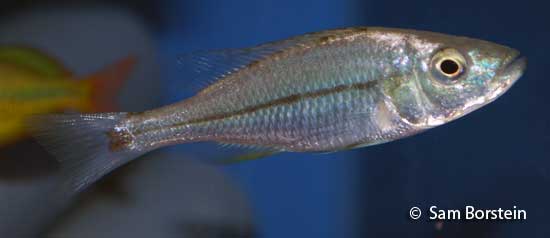Dimidiochromis dimidiatus
(Günther, 1864)
Synonyms: Haplochromis dimidiatus

Above: A male Dimidiochromis dimidiatus. Photo by Rick Borstein.
Etymology:
Genus- Di= two (Greek), midio= middle/half (Latin), chromis= a fish, perhaps a perch (Greek). In reference to the stripe down the middle of the fish that divides it in two.
Species-di= two (Greek), midio= middle/half (Latin).
Intro:
Dimidiochromis dimidiatus is a very interesting piscivorous maternal mouthbrooder from Lake Malawi. This fish, first typed by Gunther in 1864, is very elongate and is the most elongate member of the genus Dimidiochromis.
Because of its shape, behavior, and dentition, many believe this fish may be closely related to the genus Rhampochromis. It is quite possible, as this fish is very similar in body shape and behavior. It would not be surprising to find out this fish was the forefather for that genus.
Dimidiochromis dimidiatus is the smallest member of the genus Dimidiochromis, and like many of the other species of this genus, they are peaceful.

Above: A male Dimidiochromis dimidiatus. Photo by Rick Borstein.
Distribution:
Dimidiochromis dimidiatus is found throughout Lake Malawi and inhabits shallow, sandy waters.
Size, Maturity, and Sexual Dimorphism:
Size: Males- 6 inches, Females- 5 inches
Maturity: 3 inches
Sexual Dimorphism: Males are larger than females and are a lot more colorful than the females which are silver with a black horizontal line through the body.

Above: A female Dimidiochromis dimidiatus. Photo by Sam Borstein.
Care:
Caring for Dimidiochromis dimidiatus is not very difficult. The most important requirement is to give this active fish a large enough tank. Dimidiochromis dimidiatus likes hard water in the 77-80F degree range.
Because this fish is so active, be careful with tank decorations. Make sure you don't use rocks that are to sharp or other objects which could cause injury during a collision.
This fish is very peaceful and will only harm fish that will fit in its mouth. Because of this, choose tankmates wisely as many can out compete Dimidiochromis dimidiatus.
Diet:
Dimidiochromis dimidiatus is a piscivore and eats small fish in the shallows in the wild. Any meaty pellet or flake food is usually accepted by the fish without much hassle.
Breeding:
Dimidiochromis dimidiatus is easy to breed. Breeding is when the color on this fish is very evident, and they are stuinning during this time. Breeding takes place in a typical Malawi Haplochromis style.
Females are good holders and hold for about 24 days. They have very large eggs, and therefore large fry. Raising the fry I found difficult. They seem to be sensitive to water quality and are not very good eaters, so getting food to them is and issue. Another issue is when trying to get food to them, feeding to much will also kill them as it pollutes the water.

Above: A juvenile Dimidiochromis dimidiatus. Photo by Sam Borstein.
Conclusion:
This is a hobbyist fish. I really enjoyed keeping them, but they are not for everyone. This is a fish you will not find in a pet shop. It is occasionally available from hobbyists.
References:
- Eccles, D.H. & Trewavas, E. (1989) Malawian cichlid fishes. The classification of some Haplochromine genera. Lake Fish Movies, Herten, Germany, 335 pp.
- Günther, A. (1864) Report on a collection of reptiles and fishes made by Dr. Kirk in the Zambesi and Nyassa regions. Proceedings of the Zoological Society of London, 303-314 pp.
- Konings, A. (2007) Malawi cichlids in their natural habitat. 4th ed., Cichlid Press, El Paso, Texas, 424 pp.
